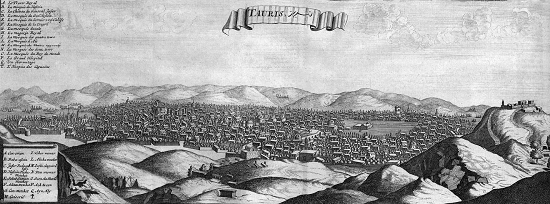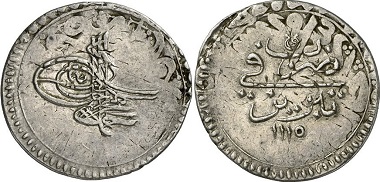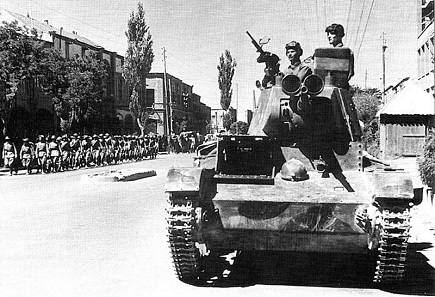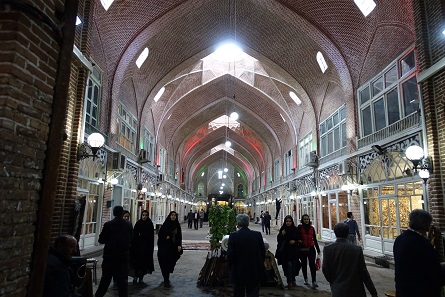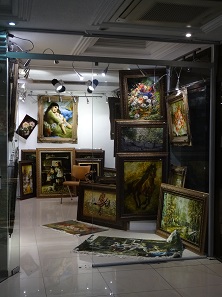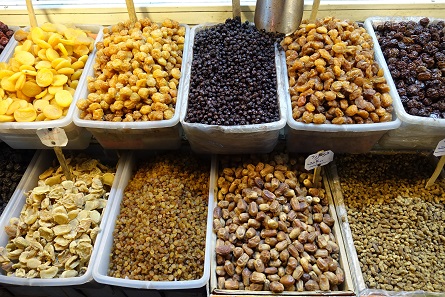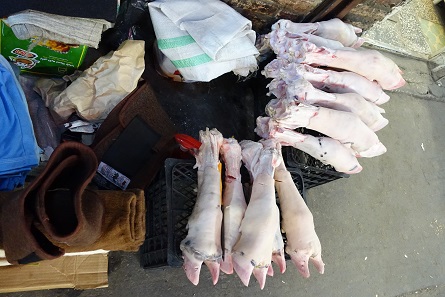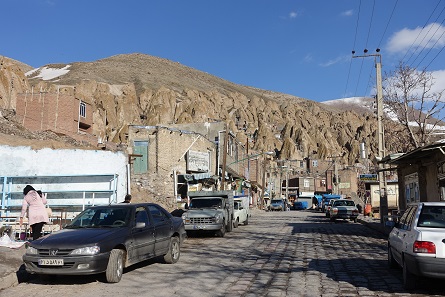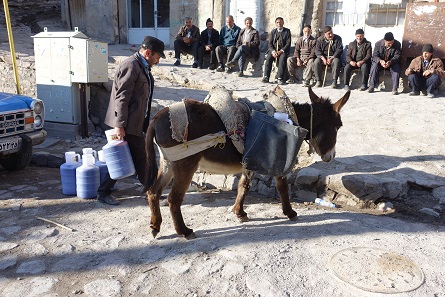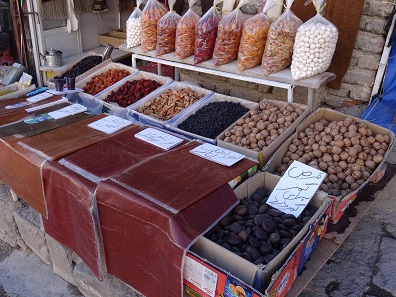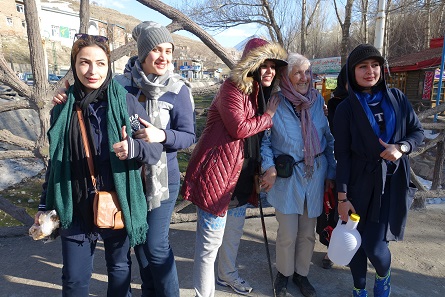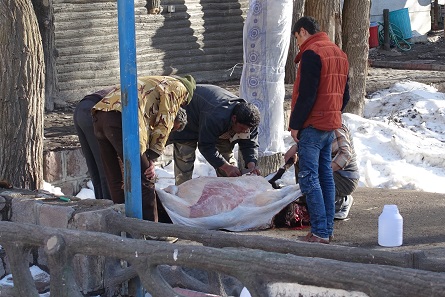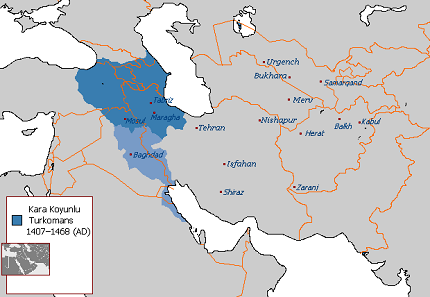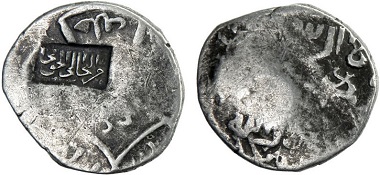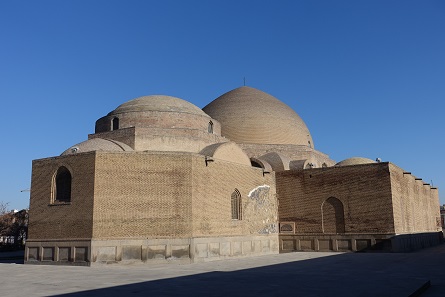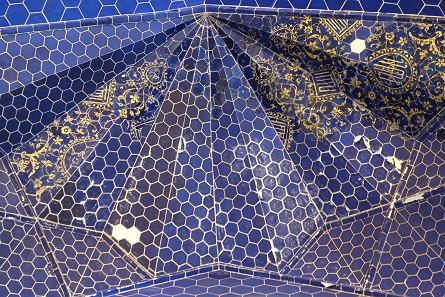by Ursula Kampmann
translated by Teresa Teklic
May 5, 2016 – Have you ever asked yourself what Iranians do for recreation? In a nutshell, everything that we do too: You drive to a nearby recreation area, eat well (and too much), stroll up and down the main street and spend more money shopping than intended. The destination closest to Tabriz is Kandovan.
Monday, 7 March 2016
Today we only left the hotel at 9.30 am! What a pleasure! We could sleep until 8.00!!! Actually the plan had been to drive to the Blue Mosque in our bus. So we went to the parking lot, got into the bus, which started driving and then, with a loud “poof,” it lowered down noticeably. Now the damn thing was definitely broken. Fortunately we weren’t in the remote mountains anymore. So then, everybody get off again.
Arg-e Ali-Shah – Never completed and then destroyed during World War I. Photo: KW.
Tabriz doesn’t offer too many touristic sights. Especially not on a Monday when museums and mosques with museum status are closed. Plus, the city lies in an earthquake region and has suffered four Russian-Persian wars.
Tabriz. From the “Journal du voyage de Chevalier Chardin” from 1687. Source: Wikipedia.
Too sad, since the city must have once been magnificent. Marco Polo, who visited Tabriz in 1275, described it as “a great city surrounded by beautiful and pleasant gardens. It is excellently situated so the goods brought to here come from many regions. Latin merchants specially Genevis go there to buy the goods that come from foreign lands.”
Ilkhanates. Gaykhatu, 1291-1295. Denarius, Tabriz. From Gorny & Mosch auction sale 226 (2014), 5170.
So Tabriz was an important trade centre and thus of course had its own mint. This Ilkhanate coin was minted shortly after Marco Polo’s visit.
Ottomans. Ahmed III, 1703-1730. Abazi, Tabriz 1703. Overstrike on a Safavid coin. From Gorny & Mosch auction sale 197 (2011), 6669.
Coins continued to be minted in Tabriz even in the Ottoman era.
Soviet tank in the streets of Tabriz during the 1911 invasion. Source: Wikipedia.
Today, little remains of the former glory. That is of course due to the earthquakes. However, the four invasions of Russia in Tabriz were no walk in the park either, and they left their traces. Let’s not forget the geopolitical situation. All Russian tsars since Peter I were eager to expand their empire, and in the 19th century the East became increasingly attractive due to the weakness of the Ottoman Empire and the Iranian Shah. Well, Tabriz had bad luck. It was too close to Russian territory …
The old bazaar. Photo: KW.
So no reason for us to be disappointed that we’d have to do without the bus for half a day. We took taxis to the city centre and that gave our bus driver Nadir half a day to either fix our bus or find a replacement.
What’s hot these days in interior design. Photo: KW.
And we had time to visit the local bazaar. That was fantastic! After all, let’s be honest, there cannot have been all that many tourists here before. Souvenirs? Nada! Instead there were all too many testimonies to the Persian taste, which does not quite go with Western minimalism. The more gold, glamour and glitter, the better.
Dry fruit on the bazaar. Photo: KW.
The bazaar did not only offer rich tapestries and paintings, but also everyday goods like underwear and pots, fabric and curtains, and of course all sorts of food.
Leg of – probably a specialty. Photo: KW.
Some things were more likely to be picked up by us, like the omnipresent pistachios, dry fruit and sweets, which are not at all as sweet as what you’d expect from the orient. Other things we preferred to leave where they were …
Honey is sold in combs here. Photo: KW.
As all bazaars, this one was organised according to trades. Only the tearooms were missing. I would have loved to make myself comfortable in some corner with a glass of tea to watch the colourful hustle and bustle, but we didn’t get a chance. And something else was missing: None of the merchants tried to drag us to his booth and force his goods on us. Not that they didn’t notice our tourist status, on the contrary. From all sides did it sound: Welcome to Iran.
Something else is also different in Iran: People don’t bargain. Prices are fixed and merchants don’t try to rip off tourists (well, apart from the really famous sights, where they have already adopted European standards). Not in Tabriz though. Some of our fellow travellers, who – just like we – had problems dealing with the Iranian money (I mean, who among us are used to paying hundreds of thousands or even millions?), handed the merchants their wad of banknotes. And they would take exactly what they were supposed to, not more, not less.
The good hour we had for our stroll around the bazaar passed much too quickly. But that is just one disadvantage of travelling with a party: Schedules are not made according to your needs but according to those of the group.
Kandovan village, built into the fairy chimneys of formed tuff rock. Photo: KW.
Waiting for us back at the hotel was a pleasant surprise: Our bus was fixed and ready to go and bring us to the picturesque village Kandovan. I wasn’t quite sure what to expect. I was told to imagine something similar to the Turkish Göreme. So I imagined deserted fairy chimneys … and we arrived in a village that still fully integrates the caves carved out of the tuff stone formations into its everyday life.
Donkeys are the most reliable means of transport considering the altitude difference here. Photo: KW.
The hotel in which we ate our delicious lunch stretched over half the hill and was partly built into the tuff. It was great but you really had to earn your lunch. Some 300 steps (or what felt like it) lead up to the restaurant. Alternatives to climbing the stairs there were none.
Dried fruit. But beware, they are not as sweet as we are used to… Photo: KW.
Kandovan is a popular destination for the locals in Tabriz. Which means that the villagers are prepared for their customers. The main street is lined with many stores which sell dried fruit. We bought some dried cherries and discovered that they had somehow been conserved with salt. I do admit the flavour of cherries and salt is an interesting combination. I don’t think I will develop a craving for it though.
Well, you have to dry your laundry somewhere, don’t you ? And that road sign is just in the right place. Photo: KW.
But don’t think of this as a purely touristic village as you know them from Turkey, Southern France or Italy. You don’t see souvenir shop after souvenir shop lined up. Instead the male elderly locals are sat on the little benches in the village square, commenting on everyone who passes by.
More people took photos of us than we took photos of them. Photo: KW.
And anyway, those Iranians. Getting in contact with them was the main attraction of that village. A few young women from Tabriz were immensely proud of their English and wanted to take a picture really badly.
Slaughtering the lamb for dinner. Photo: KW.
Just next door a lamb was being slaughtered, skinned and dissembled. Now some of you may find that disgusting, but to me it seemed much more natural than buying your meat neatly wrapped and packaged in plastic foil for 9,99 in the supermarket.
Afterwards we turned homewards again. We skipped dinner since our late lunch at 2.00 had been more than filling. And you still have to write your diary at some point, right?
Tuesday, 8 March 2016
Today our first destination was the Blue Mosque in Tabriz. It was built by the wife of a tribal leader, whose tribe was known under the funny name of the Black Sheep Turkomans.
Speaking of which: territories of the Black Sheep Turkomans. Source: Arab League / Wikipedia.
Jahan Shah, spouse of the builder of our Blue Mosque, was the most powerful ruler of this empire. And Tabriz was its capital.
Coin of Jahan Shah’s brother: Iskander, 1420-1438. Tanka with chopmarks. From Stephen Album Rare Coins 15 (2013), 580.
Just how important the Jahan Shah was shows in the fact that Alexius IV from the Empire of Trebizond did not only pay tribute to him, which had previously gone to Tamerlane, but also gave him his daughter to marry. (I don’t want to know what the daughter had to say about this idea of her daddy.)
The Blue Mosque. Not really blue (yet) from this perspective. Photo: KW.
But back to business. This Jahan Shah, who was among the most powerful men of the 15th century in the Middle East, and who alarmingly few people know of in this part of the world, lies buried in the Blue Mosque of Tabriz. After its destruction due to a severe earthquake, the mosque underwent reconstruction and restoration works in the last six years, which did not only integrate leftover original parts but were also executed very well.
A look into the Blue Mosque. Photo: KW.
The site offers a wonderful insight into what the building must have looked like once, without the common disneyfication which wants to make you believe the building never suffered any form of destruction.
Blue with delicate golden ornamental painting. Photo: KW.
The Blue Mosque derives its name from its former decoration with tiles in all shades of blue and turquoise that you can think of.
The dome. Photo: KW.
The most impressive part of the mosque is the gigantic dome that spans the mosque’s main hall. It was an exhilarating experience, especially because the site – just like most other times – was completely empty but for our party. I guess Iran cannot (yet) complain about too many tourists.
On the other hand this situation brings some disadvantages with it, such as the appalling lack of public toilets. When we’re already at it, let’s talk about this somewhat embarrassing topic. Toilets are spread out thinly in Iran. Most of them are squat toilets and most of them are in a worse condition than you’d like them to be. Although, granted, the really dirty toilets are limited to those areas with many foreigners who don’t know how to use a squat toilet properly. On our trip we visited public toilets in cities no tourist had ever been before and they were the cleanest of all.
In case you were wondering: No, I will not give instructions on how to use a squat toilet here. I leave it up to you to find that out for yourself. Just one thing: Never, ever, no matter how exquisite the hotel in which you find yourself, throw toilet paper into the toilet bowl. The pipes are simply not made for that. You’ll risk them clogging up. And I promise you, you do not want that to happen.
To cut a long story short. There were no toilets at the Blue Mosque, even though it is Tabriz’ main attraction. That posed a certain problem to a tourist party after breakfast and before a three-hour bus ride. Our local guide Ehsan heroically solved the problem: He made a deal with the neighbouring museum so that we could use their facilities.
A really quick glance at the coin collection at the Azerbaijan Museum. Photo: UK.
Thank God the museum had no more than two toilets. With a group of 22 people that left enough time for me to run up to the museum’s top floor and throw a quick glance at the coin collection. So should you ever get the chance to visit Tabriz, don’t miss out on the Azerbaijan Museum. Although the condition of the coins offers little reason for enthusiasm, the careful consideration that has gone into presenting them reveals the affection of its presenters and delights every numismatist. And by the way: There are still many empty spaces for missing pieces, so maybe a noble donor will show himself and close a few gaps in the museum in Tabriz …
The next part of the series talks about the city Ardabil, where you can see the splendid burial site of the founder of the Safavid Dynasty. We also visit the gravesite of Jude the Apostle that I actually promised you for this part. Still, I didn’t want to deprive you of the stories about Iranian everyday life …
You can find all episodes of the Iranian Diary here.






